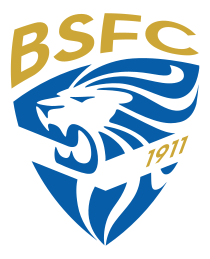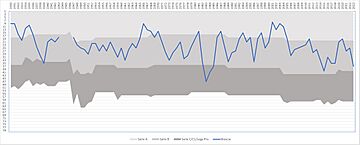Brescia Calcio facts for kids
 |
||||
| Full name | Brescia Calcio S.p.A. | |||
|---|---|---|---|---|
| Nickname(s) | Le Rondinelle (The Little Swallows) I Biancazzurri (The White and Blues) La Leonessa (The Lioness) |
|||
| Founded | 17 July 1911 | |||
| Dissolved | 2025 | |||
| Ground | Stadio Mario Rigamonti | |||
| Capacity | 19,500 | |||
| Owner | Massimo Cellino | |||
| President | Massimo Cellino | |||
| Head coach | Rolando Maran | |||
| 2018–19 | Serie B, 1st of 19 (promoted) | |||
|
||||
Brescia Calcio was a famous Italian football club. It was based in the city of Brescia, in the Lombardy region of Italy. The team's last league was Serie B, which is the second-highest football league in Italy.
Brescia held a special record in Serie B. They played there for 66 seasons in total. They also played 18 seasons in a row, from 1947 to 1965. Brescia won the Serie B title four times. Their best finish in Serie A, Italy's top league, was 8th place in the 2000–01 season.
In the early 2000s, a very famous player named Roberto Baggio played for Brescia. He had won the 1993 Ballon d'Or, a big award for footballers. With Baggio, the club also played in the UEFA Intertoto Cup twice. They even reached the final in 2001. Other well-known players like Pep Guardiola and Andrea Pirlo also played for Brescia. Pirlo started his career in Brescia's youth team.
The team's colors were blue and white. Their home stadium was the Stadio Mario Rigamonti. It could hold 19,550 fans. Brescia had a long-standing rivalry with Atalanta, a team from a nearby city. Sadly, Brescia Calcio stopped playing professional football in July 2025 due to financial issues.
Contents
History of Brescia Calcio
The club started in 1911 as Brescia Football Club. They joined a lower division that same year. By 1913, Brescia was promoted to the First Division. They were one of the founding teams of Serie A in 1929-30. Brescia played in Serie A for six of the next seven seasons.
The club only dropped out of the top two Italian leagues a few times. This happened in 1938, 1982, and 2025. In 2025, they faced problems that led to them leaving professional football. Brescia played more seasons in Serie B (66) than any other Italian club.
Major Achievements and Famous Players
Brescia won the Anglo-Italian Cup in 1994. This was one of their biggest achievements. In 2000, the club became even more famous. They signed Roberto Baggio, a former FIFA World Player of the Year. Baggio helped Brescia finish 7th in the 2000–01 season. This allowed them to play in the UEFA Intertoto Cup. They reached the final but lost to Paris Saint-Germain.
Roberto Baggio played for Brescia for four years. During this time, the team was often called "Baggio's Brescia." After Baggio retired in 2004, Brescia was relegated from Serie A. They returned to Serie A in 2010 but went back to Serie B the next year. They were promoted again in 2019 but were relegated after just one season.
The Final Season
In the 2024–25 season, Brescia finished near the bottom of Serie B. They avoided the automatic relegation spots by a small margin. However, the club faced serious financial difficulties. On July 3, 2025, the Italian Football Federation confirmed that Brescia could no longer play professional football. The club was officially dissolved.
Team Colors and Badge
|
|
| The traditional home kit |
Team Colors and Kit Design
Brescia's first kit in 1911 was blue with a thick white stripe. This design came back for the club's 100th anniversary in 2011. The famous white "V" shape on the shirt first appeared in 1927. It was added so the team could use a new stadium.
Over the years, the kit design changed several times. Sometimes the "V" disappeared, and sometimes it returned. Since 1991, the "V" has been a regular part of the home kit.
The Club Badge
The first badge on Brescia's kits appeared in the 1980s. It was a blue crest with a golden lion. The city of Brescia is known as Leonessa d'Italia, which means "the Lioness of Italy." This nickname came from a brave uprising in the city in 1849.
The badge was updated in 2011 for the club's 100th birthday. It got a gold shield and laurel branches. The lion on the badge was also redesigned to look stronger and more fierce.
Home Stadium
Brescia's first football ground was Campo Fiera. In 1911, a new fenced ground was built on Via Milano. In 1920, the team moved to a new ground on Via Cesare Lombroso.
In 1923, they moved to an even bigger stadium called "Stadium" at Porta Venezia. In 1956, the city decided to build a better stadium for Brescia. They renovated the existing ground at Via Giovanni Novagani. This new stadium was finished in 1959. It was named Stadio Mario Rigamonti, after a famous football player who died in a plane crash.
The stadium has been improved many times over the years. Important updates include adding a roof and a press room. In 2007, new safety features were installed.
Famous Players and Managers
Retired Jersey Numbers
Brescia Calcio honored two players by retiring their jersey numbers:
- Number 10 was retired for Roberto Baggio. He was a forward who played for Brescia from 2000 to 2004.
- Number 13 was retired for Vittorio Mero. He was a defender who played from 1998 to 2002. His number was retired after his death.
Other Notable Players and Managers
Many other talented players and managers have been part of Brescia Calcio's history. You can find more information about them in the full lists of former players and managers.
Club Honours
Brescia Calcio won several important titles during its history:
- Serie B Winners (4 times):
- 1964–65
- 1991–92
- 1996–97
- 2018–19
- Serie C/C1 groups Winners (2 times):
- 1938–39
- 1984–85
Other Trophies
- Coppa dell'Amicizia Winners (1 time): 1967
- Anglo-Italian Cup Winners (1 time): 1993–94
- Nova Supersports Cup Winners (1 time): 2000
Images for kids
See also
 In Spanish: Brescia Calcio para niños
In Spanish: Brescia Calcio para niños




